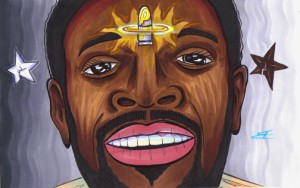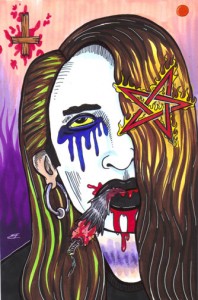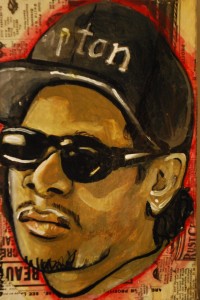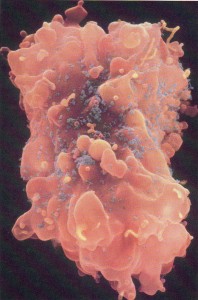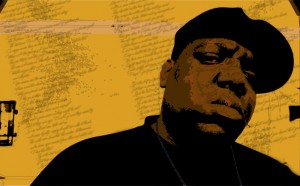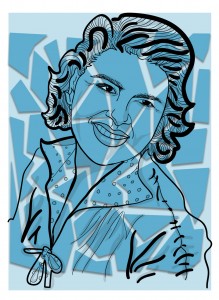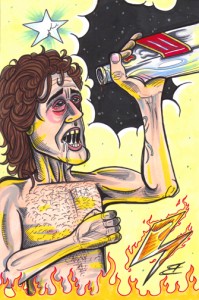In private moments otherwise shrouded in darkness, Christians feel the presence of God looming over their shoulders. The Omniscient Eye bears witness to every messy indiscretion behind closed doors and probes dirty thoughts like a supernatural panty-raider.
In view of their popular images, Marvin Gaye and Rozz Williams seem as different as sly grins and slit wrists, but the camera overlooks their common heritage. They were both children of a church-dwelling God, and His relentless imposition of conscience drove both them to the very edge of sanity—where they promptly jumped into the Abyss.
Both met their Maker on April 1st. No foolin’.
Marvin
Marvin Gay Jr. grew up under the thumb of the “Hebrew Pentecostal” House of God denomination. His father, Marvin Gay Sr., was an ambitious preacher in the Washington DC congregation, and swung an iron fist on any defiant soul living under his roof.
The rules were simple: No make up, no television, no wine, no swine, no sweethearts, no playing after dark, no bed-wetting, and don’t even think about having fun.
The ministry brought many blessings to the Reverend Gay—despite his hobgoblin visage—including the loose “sisters” of the congregation who were more than willing to service a man of God under the nose of his timid wife. In his own mind, the pastor was destined to become a big time prophet. His dreams of sainthood were shattered, however, when theological rifts within the House of God left him with a meager flock to tend.
Defeated and disillusioned, the failed spiritual leader retreated into the quiet sanctum of his stank bedroom, where he would slip into his wife’s silky dresses and nylon stockings, swig jugs of liquor, and stare into the mirror while wearing a stringy, honky-haired wig. If that got boring, he would just go out and slap his family around. He particularly despised his handsome and talented son, Marvin Gay Jr., calling him a “sinner” and a “faggot” for abandoning the choir to sing the Devil’s boogie-woogie.
Marvin Jr. escaped this oppressive teenage existence by joining the Air Force in 1956. He didn’t much care for the military’s rules, either, but at least he got a chance to “do the nasty” off base—with a blubbery whore at Patsy Prim’s Cathouse. This two-pump poke-down was hardly the sacred act Marvin’s preacher had talked about and the post-coital guilt nearly crushed the young man’s soul.
Within a year, Marvin was granted an honorable discharge after faking the crazies. He headed back to his old ‘hood in DC, moved in with a sexy new girlfriend, and set about becoming a star. Of course, there was one final tie to sever. Upon realizing that the slang of the day had shifted against his surname, he immediately added the now-familiar “e” to dispel any confusion. Can you blame him?
Marvin made his way to Detroit in 1959, where he would find his destiny in Anna Gordy—a gorgeous, world-wise woman seventeen years his senior. She immediately fell in love with Marvin’s voice, and soon insisted that her brother—the founder of Motown Records—give him a listen. Berry Gordy saw an R&B star ready to burn, and wasted no time buying the rights to the singer’s soul. Before long, Anna Gordy said, “I do.”
In the early days of his touring career, Marvin remained faithful to Anna. He was content to just smoke a joint, rub some cocaine on his gums, and cozy up in his hotel room with a stack of skin mags. After awhile, though, he began to bring a prostitute or two into the mix. Perhaps it was a lingering tendency from porn-consumption, but he generally preferred to simply watch his hired help undress and fondle each other. If the specter of guilt arose, he would remind himself that the Patriarchs of the Old Testament were polygamous, so why shouldn’t he enjoy some variety?
“Prostitutes protect me from passion,” Marvin maintained. “Passions are dangerous. They can cause you to lust after other men’s wives.”
Publicly, Marvin was famous for his steamy duets, but it was pure magic when in 1967 he stepped into the national spotlight with the vibrant Tammi Terrell singing by his side. While race riots set Detroit on fire, America gazed in wonder as Tammi and Marvin sang of precious love, and for a moment it seemed possible that there “ain’t no mountain high enough” to keep true lovers apart.
Then one night Tammi fainted into Marvin’s arms onstage. Doctors discovered a tumor in her brain. A series of unsuccessful operations left the once gorgeous performer in a wheelchair—blind, bald, and unable to perform the simplest tasks. Marvin was so distraught that he would not go onstage again for four years.
Throughout Tammi’s decline, Marvin sought peace in solitude, reefer, and spiritual self-help books like Carlos Castaneda’s The Teachings of Don Juan. “I would like to become a man of power and knowledge,” he proclaimed to one interviewer. At 31, he developed megalomaniacal athletic aspirations. He played basketball, took up boxing, and even considered trying out for the Detroit Lions—to everyone’s amusement. The numby gummies had lost their luster at this point, so Marvin began sniffing instead.
Continuous television coverage of Martin Luther King’s assassination, the endless Vietnam War, and America’s deteriorating black ghettos erupted upon Gaye’s consciousness, stirring his troubled soul. He turned to the Spirit, gravitated toward New Age Gnosticism, and became convinced that the End was nigh—but that he was chosen by God to lead the Spiritual Elite to glory.
The long-awaited release of What’s Going On in 1971 took everyone by surprise. Beneath the album’s soothing vocals is a call for social justice, a wail of racial despair, and a warning of immanent ecological and/or nuclear catastrophe. Emerging from this hopeless vision is the plea to just save the children. Backed by groovy percussion and fronted by Marvin’s winning smile, the project was a smash hit whose impact endures to this day. The revolutionary youth fell in love with it. Marvin was no longer “The Sound of Young America.” On this album, he became the Voice of Black America.
Janis Hunter was also in love. The young girl stopped by the studio one day in 1973, and Marvin could not help himself. Her creamy, Cuban complexion, her lithe body and bubbly admiration—it was just too tempting. His wife Anna was 51 at this point—seventeen years older than Marvin. Janis was seventeen years younger—making her seventeen years-old. She was Marvin’s last chance to bask in innocence, purity, and the naïve optimism that is the folly of youth. Janis had much to learn.
This period saw the release of such seductive hits as “Let’s Get It On” and “You Sure Love To Ball.” Marvin left his humiliated wife and retreated with his little love bunny to a rugged cabin on the coastline. By the late 70s, Marvin and young Jan were married with children. They toured the world on a wave of erotic fame, snorted snow drifts of cocaine, and strained the limits of bizarre sexual pleasures.
Marvin’s New Age obsessions continued. He got into biofeedback and vegetarianism, wore brass pyramids one his head around the house, and remained convinced that Armageddon would soon purge the Earth of the unworthy—leaving him and the Elite to start anew. Perhaps these survivors would listen to sexy R&B tunes while disposing of irradiated mutants.
Marvin’s adventurous nymph eventually grew tired of his power trips and started exploring other partners. The early 80s found Gaye holding the #1 spot with “Sexual Healing,” while Teddy Pendergrass and Rick James were laying hands on his young wife. It drove Marvin to slap Jan silly, but he also blamed himself for corrupting her.
Time rolled over him like a train to Batshitville. The End was nigh, and his nostrils were blown out. Marvin took to free-basing instead. He did one last tour in 1983 to scrape up cash. Sometimes he brought multiple couples up to his hotel room, and had them soak his sheets with some midnight love while he stopped, looked, and listened.
He would occasionally repent in desperate moments, once smashing a glass pipe under a Bible as a symbolic gesture. Again and again, he vowed to live a life of purity and ferociously condemned the drug use of his companions. God forgives. Jesus is the Truth and the Light. But cocaine was readily available. A million dollars, a million record sales, a million brain cells boiling on aluminum foil and sucked through a glass tube. That shit is terrible for your teeth.
Threatening voices emanated from the television set like gakked-out Jiminy Crickets. Marvin would frequently dismantle telephones to search for recording devices. His soul was exposed. Everyone was out to get him. Maybe they would come after his parents instead. His beloved mother! Marvin sent his father an unregistered .38 pistol, just in case.
In Marvin’s mind, he was the biggest star in the world. A Savior of the human race. But his sins were rotting hot dogs stuck to his ribs, and the hounds of Hell drooled in the shadows. Groupies’ husbands, Jan’s father, unpaid drug-dealers, radicalized black supremacists, Berry Gordy’s henchmen, the FBI, the IRS, and of course, God Himself had a bone to pick with Marvin Gaye. One night he thought the Devil had finally come for him, and his bodyguard found him blabbering on the hotel bed with 666 pasted to his sweaty forehead.
The last months of Marvin Gaye’s life were spent under his father’s roof in the suburbs of LA. Marvin had bought the home for his parents some years back, but was still ashamed to live there. He was forty-four, fat, balding, bankrupt, and estranged from both Anna and Jan. His children were kept from him, and his career was all washed up.
Threats of suicide became commonplace but Marvin considered that to be an unforgivable sin. So he holed up in his darkened bedroom wearing a soiled bathrobe, consumed quantities of coke and PCP, and stared out the window for his coming assassins. Like father, like son. One close friend claimed that in his isolation, Marvin had taken up “some weird sexual thing” so perverse the friend refused to give details. I have my guesses, though.
Marvin’s father stayed drunk and disgusted with his son. His mother prayed for him in tears. Marvin just disintegrated. Then, without warning, Judgment Day arrived.
Marvin was laying on his bed talking to his mother, when his father came to the door griping about a lost insurance policy. He cursed at Marvin’s mother like she was a dog. So Marvin leapt from the bed and began to beat the shit out of him. “Motherfucker, you want some more?” He punched and kicked the pitiful old man repeatedly, then returned to his room.
Marvin Gay Sr. took the .38 his son had given him, walked to Marvin Jr.’s room, and shot him in the chest—then popped one more into his torso for good measure. Marvin Gaye was pronounced dead on April 1, 1984—one day before his forty-fifth birthday.
People close to him said that Marvin intentionally took his own life by his father’s hand. It puts a twisted spin on Jesus’ last words on the cross: “Father, into your hands I commend my Spirit.”
Marvin Gay Sr. had warned Marvin Jr. many times, “I brought you into this world, and if you lay a hand on me I’ll take you out.” If nothing else, he was a man of his word. While in jail, a reporter asked Marvin Sr. if he loved his son. After some hesitation he replied, “Let’s say that I didn’t dislike him.” It turns out that Marvin Sr. had a wicked brain tumor. He was given five years probation for voluntary manslaughter and confined to a nursing home, where he gradually lost his marbles.
“I could never imagine [Marvin Gaye] living to be an old man,” Jan said of her late husband. “He was drawn to danger[...] The dark side of life and the dark side of the mind really fascinated him. There was stuff that just went so deep, so dark and so bizarre. That was the driving force with him for many years.”
Rozz
There was nothing gradual about Rozz Williams’ descent into darkness. One day it was Gummy Bears, the next it was bears at the leather bar. The little guy was so precocious, he might as well have been born into an open grave.
Raised by Southern Baptist parents on the outskirts of LA, Roger Alan Painter found his Savior to be repellent at an early age. He had too many questions and the church’s vapid answers were hardly satisfying.
Why is the world so mean?
(Jesus loves you)
Who am I?
(Jesus loves you)
What do I do with all these erections?
(You’ll go to Hell)
Is that all there is?
(Jesus loves you)
The kid was bored to death and willing to try anything to break free. Rock n’ roll was the obvious choice.
In 1979, at the age of sixteen, he founded the seminal goth band from which all black nail-polish still flows: Christian Death. The name Rozz Williams was lifted from a tombstone in a neighborhood cemetery. I have no idea where he picked up that haunted, faux-Shakespearean accent. Not southern California.
Rozz’s church-going parents were alarmed at their son’s penchant for flamboyant blasphemy—especially after seeing his tapes condemned by pastors on TV—but what were they gonna do, spank him? He was already dressing like Boy George-meets-the-Exorcist and bringing boyfriends home so he could strip them down and tie them up and wrap them in plastic and cut them up with razor blades and lick their bloody wounds and then hold hands in public.
The details of Rozz’s private life are pretty murky, but he was never shy about expressing his perversions onstage or on film. This guy was cutting himself when blood-sucking was still left to Béla Lugosi, performing Crowlean black magic rituals at the height of the Satanic Panic, and openly defying gender norms back when LGBT was just a funny way to spell lug-butt.
“I’ve never understood the idea that men are supposed to wear pants and women are supposed to wear skirts[,]” Rozz mused. “We both have male and feminine sides to ourselves, so there’s no reason not to explore them.”
His breakout moment was with Premature Ejaculation in 1980. It was a bit of nasty performance art created in LA with his gothic dreamboat, Ron Athey. Inspired by massive amounts of acid, heroin, and yes, sado-masochistic games with preteen boys, this visual representation of animal abuse included a boy tied up on the floor, handfuls of putrid animal organs hucked at the crowd, the live crucifixion of a rotten roadkill kitty from which Ron took a few bites, and subsequently, a great deal of vomiting.
“I’d rather play a show which the audience walks out of en masse, than one they just stand around and talk through.”
His goth rock career took off in 1982 with the release of Christian Death’s Only Theater of Pain (not to be confused with Mötley Crüe’s pseudo-satanic Theater of Pain, released three years later.) Rozz took the stage in pancaked corpsepaint, black lipstick, silk gloves, smoldering cigarettes, and a flowing white wedding dress that just screamed, “She’s a liar!”
The lyrics ranged from the Jesus/Satan dichotomy to candlelit pederastic romance. You’d think he was raised Catholic. An amoral tone of dispassionate curiosity was established early on, which would endure throughout his subsequent work. Rozz sang:
Burning crosses on a nigger’s lawn
Burning money, what’s a house without a home?
Dance in your white sheet glory
Dance in your passion
[…]
Kiss on my hand
After dark
Hand for a kiss…
People weren’t sure what to make of it. Was it ironic satire? Sadistic indulgence? Soulless observation? Gothic nonsense?
Rozz explained, “I feel that people should be allotted freedom to look into whatever it is they’re looking into, and make up their own mind about it.”
After Rozz crucified himself at the Whiskey A Go Go on Easter weekend, few people in the press were asking him any questions, anyway. Christian Death came years before Madonna made out with black Jesus and Robert Mapplethorpe peed on crucifixes—sacrilege hadn’t gone mainstream yet.
By this time, Rozz had fallen head over heels for his wife-to-be, Eva O, a vamped-out, guitar-slung “queen of darkness” who occasionally played with Christian Death. She had recently left a relationship with the pentagram-emblazoned serial killer, Richard Ramirez, so she was ready for a rebound. Considering the fact that preshy-poo Rozzy wrote letters to Jeffrey Dahmer and pored over Charles Manson’s rambling philosophies, you have to wonder where him and Eva hid the bodies.
Eva and Rozz began writing songs for Shadow Project together in the late 80s. The name refers the charred “shadows” left on concrete walls by the vaporized victims at Hiroshima, and the sound was pure death rock—which is akin to straightforward rock n’ roll, but with a consistently, obsessively, slavishly morbid twist.
Christian Death became a goth sensation in America and Europe, and was to be Rozz’s most widely known work. But Rozz soon found himself bored with this project, as he eventually did with most things in life. He allowed the guitarist, Valor, to take over the group under the condition that they drop the name and not play Rozz’s songs.
“Call yourself ‘Satanic Life’ or ‘Evil Watermelon,’” I can hear Rozz saying, “But don’t use my material. Deal?”
“I am in such mortal anguish,” Valor moans, “but okay—deal.”
“Blood oath?”
“But of course.”
Slice. Slice. Splat.
Rozz fluttered off on bat wings, and Valor immediately started touring both sides of the Atlantic as Christian Death, playing all of Rozz’s songs. Which pissed Rozz off—but he took it like a sport, really. Everybody copied Rozz Williams—that’s just how things were. And after all, he had other things to occupy him.
There were snuff films to watch and demons to conjure and poetry to compose, and of course, heroin to zap up his veins. Gobs of gooey, womb-like, feel-no-pain-when-you-cut-yourself-with-an-old-school-razor-blade smack-in-the-dirty-needle. Bang! Zooom! To the moon, Eva!
Although Rozz would occasionally do Christian Death reunion shows—withdrawals are a bitch—he was always focused on the next endeavor. Shadow Project’s second album, Dreams for the Dying, was recorded while locked in their LA studio during the race riots of ’92. The songs are among his most deranged. It seems that Rozz was devoted to one mission throughout his career: Explore the underbelly of the Universe. Transgress every taboo. See what happens.
“What I like to do with anything I do is push it past the boundaries. I like to break a lot of new ground and try new things[...] We’re not interested in staying in a format, we don’t want to be labeled as just a gothic band.”
Rozz detested labels. Christian, Satanic, good, evil, gay, straight, normal, perverted, junky, rockstar—mere words!
“Everybody’s a human being,” Rozz insisted, despite evidence that he was a ring wraith. “And if you want characters, then create them on paper or something, don’t expect people to be your characters.”
[Oops]
Eva O became a born-again Christian in the early 90s. Although she continued playing Jesus Freak goth, Shadow Project was disbanded in 1994. Her marriage to Rozz—which he described as “a very informal marriage, more of a partnership”—was dissolved soon after. They would go on to record one final album together, not long before Rozz’s death. The tearfully sentimental From the Heart was released later that year.
Rozz continued to explore the oozing, Id-saturated mess that was his soul. His musical output—or whatever you want to call it—was constant, leaving the world an endless stream of cassettes to ponder. One of his last formal projects was the spoken word album, From the Whorse’s Mouth, written during a period of intense heroin addiction in 1996.
Without question, the most disturbing track is “Raped.” The recording combines Rozz’s poetry with snippets of Porky Pig’s voice, advertisements for gay porno, and an answering machine message from an obscene caller named Frank Lee, retrieved from an abandoned police station. Porky Pig stutters, Frank Lee threatens to sodomize a young child, and an enthusiastic barker promises potential customers “the hottest fist-fucking double fuck films ever made.”
Granted, this is pretty tired material for anyone who has clicked between YouTube, CNN.com, and BrutalManLove.xxx, but in ’97 it was a cult classic—a coveted glimpse into the evil that men do. But why would anyone want to hear that?
I had a good friend who adored Rozz Williams, but he’s not available to answer that question. After a brief, dysfunctional marriage to his body, he shot up a fatal dose in the underbelly of Detroit.
“I’m not saying I don’t have hatred toward myself,” Rozz said, about a year before he died. “There are certain things that I despise about myself, but I try to direct those things out of myself into something that can be positive.”
Also, “Frank Lee is my hero.”
Curiously, he went on to say, “I have a personal relationship with Christ, and that’s mine—it doesn’t belong to a church or an organization[...]
“I believe in [God and Satan] as literal—it’s also things you see day to day. As simple as someone passing you on the street and saying ‘hello,’ which most people do not do—they pass you by and give you a dirty look.”
His last undertaking was a short film with Nico B., in which a faceless killer kidnaps a hairless male youth, ties him up in an abandoned house—pauses to read from some infernal tome—and then proceeds to slowly mutilate and murder him. “Let’s say, if I weren’t doing this on film, you would be talking to me from a prison cell right now,” Rozz explained. “I’m living out some fantasies on film.” Which is entitled Pig.
Rozz was also working hard on his paintings and collages, and had kicked heroin for some time at this point. According to Nico B., Rozz remained clean until his dying day. He continued to knock back plenty of booze, however, and was left extremely depressed after the suicide of his best friend, Erik Christides, in 1997. People said Rozz looked unhealthy. Rumors spread that he had contracted HIV.
On April 1, 1998, Rozz was supposed to catch a movie with Nico B., but didn’t show. When his friends finally busted into his apartment, they found Rozz dangling from his doorway with the “Hanged Man” Tarot card laying nearby. He was 34. Many fans were disappointed that he left no suicide note, but having reviewed Rozz Williams’ prolific lyrics and visual art, I think a note would be a bit redundant.
“In 1994 Rozz told me he had accepted Jesus,” claimed his would-be widow, Eva O, “And before he died he called his mother and let her know that he accepted the Lord. In his last conversation with his roommate he said he was going to be with God. I believe he is safe now.”
When an interviewer mentioned that Rozz has been described as “an angel” by some, Nico B. responded:
“Well, he’s an angel now. I think he was a devil sometimes! (laughs) You know, when he was having fun[...] But he was a very humorous person as well.”
He was obviously fond of April Fool’s Day.
Eulogy
In his coffin, Marvin Gaye wore the white military uniform from his last tour. I’m going to go out on a limb and say that Rozz Williams wore something black, with black underneath. Around 10,000 people viewed Marvin’s body at his memorial service. As far as I know, only a handful paid respects to Rozz’s remains.
Both were cremated. Marvin’s family offered his ashes to the Pacific Ocean from the deck of a yacht. Rozz’s family sprinkled his remains into Runyon Canyon, CA. The state of their eternal souls remains a mystery.
Marvin Gaye was inducted into the Rock n’ Roll Hall of Fame on 1987, where his legacy continues to enamor the public. Rozz was given a memorial niche at the Hollywood Forever Cemetery in 2001, and a plaque that reads:
All truth is parallel
All truth is untrue
For those who can muster the strength to carry on, Life is a precious struggle. As for those who cannot, their memories are enshrined as the living see fit. Who can say what is or is not forgivable?
© 2011 Joseph Allen
Marvin Gaye — “What’s Going On/What’s Happening Brother?”
1970s
Christian Death — “Romeo’s Distress”
1990s
For Vadim
